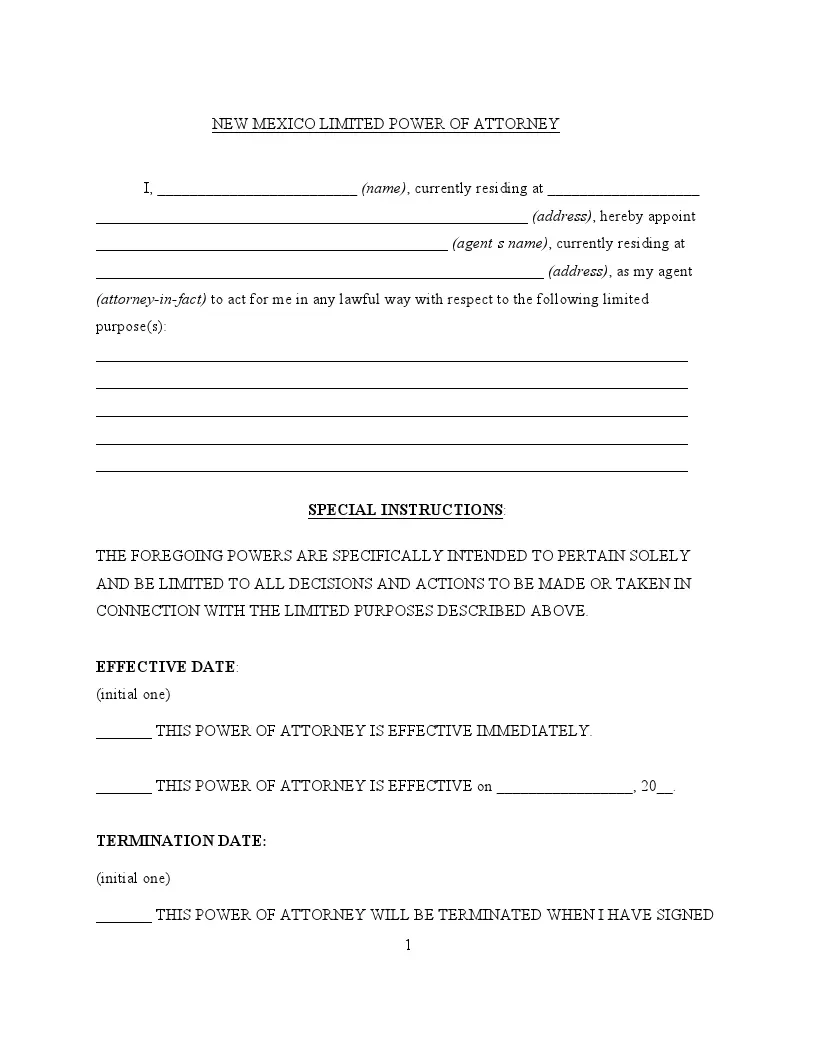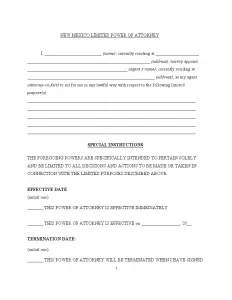New Mexico Limited Power of Attorney Form
A New Mexico limited power of attorney is a legal document that grants a designated person the authority to act on behalf of someone else, but only within specific, clearly defined situations. In contrast to a general form that grants the agent broad authority over the principal’s affairs, a limited power of attorney narrows this scope significantly.
For example, the agent may be given the authority to sell a property in New Mexico or handle specific financial tasks solely during a specified period when the principal is unavailable or incapacitated. The principal has the freedom to tailor the power of attorney to fit precise needs, specifying what the agent can and cannot do. In New Mexico, as in other states, the document must identify the parties involved, detail the powers granted, and be signed by the principal.
Check out the various New Mexico power of attorney forms available for this state and choose the one that meets your needs.

Build Your Document
Answer a few simple questions to make your document in minutes
Save and Print
Save progress and finish on any device, download and print anytime
Sign and Use
Your valid, lawyer-approved document is ready
Creating a limited power of attorney in this state must adhere to specific legal stipulations outlined in the New Mexico Statutes §§ 45-5B-101 to 45-5B-403 (Uniform Power of Attorney Act). This act defines a “power of attorney” as any writing or record that authorizes an agent to act on behalf of the principal.
For a limited power of attorney to be legally binding in New Mexico, the document must meet specific signing requirements:
- Presence of a notary professional.
- Verification of the principal’s competence and capacity.
These requirements ensure that all parties understand the document’s terms and the extent of authority granted. A notary public must be present during the signing to verify the individuals’ identities and oversee the document’s endorsement, ensuring it meets all legal standards.
Additionally, a power of attorney can be revoked at any time as provided under § 45-5B-110 of the act, allowing the principal to withdraw the authority given to the agent when desired.
New Mexico Limited Power of Attorney Form Details
| Document Name | New Mexico Limited Power of Attorney Form |
| Other Name | New Mexico Special Power of Attorney |
| Relevant Laws | New Mexico Statutes Annotated, Section 45-5B-201 |
| Avg. Time to Fill Out | 8 minutes |
| # of Fillable Fields | 32 |
| Available Formats | Adobe PDF |
Filling Out New Mexico Limited POA
Completing a limited power of attorney in New Mexico allows you to appoint someone to handle specific tasks on your behalf. The steps below guide you through filling out this form to ensure it’s legally binding and accurately reflects your intentions.
1. Enter Your Full Name and Social Security Number
Start by entering your full legal name where indicated. Then, write your social security number in the designated space. This information is crucial for identifying you as the principal granting the power.
2. Designate Your Attorney-in-Fact
Specify the full name of the person you are appointing as your attorney-in-fact. This individual will have the authority to act on your behalf. Ensure that their name is spelled correctly to avoid any confusion.
3. Provide the Attorney-in-Fact’s Address and Phone Number
Fill in the complete address and contact phone number of your attorney-in-fact. This information is necessary for official communications and must be accurate to ensure they can be contacted regarding matters under this power of attorney.
4. Define the Powers Granted
Detail the specific powers you are granting to your attorney-in-fact. Be as clear and precise as possible in listing the tasks or decisions they are authorized to handle. It could include property management, financial transactions, or other specified duties.
5. Sign and Date the Document
Once all other sections are completed, sign the document in the presence of a witness or notary public. It is crucial that this signing is done correctly to meet legal standards. Write the date next to your signature to indicate when the power of attorney was executed.
6. Notarization
Take the document to a notary public. The notary will verify your identity and witness your signature, and then they will seal the document. Notarization validates the authenticity of the power of attorney.
7. Store and Share the Document
After notarization, keep the original document safe and provide copies to your attorney-in-fact and any institutions or individuals who will interact with your attorney-in-fact under this power. This ensures all parties are aware of the extent of the powers granted.
